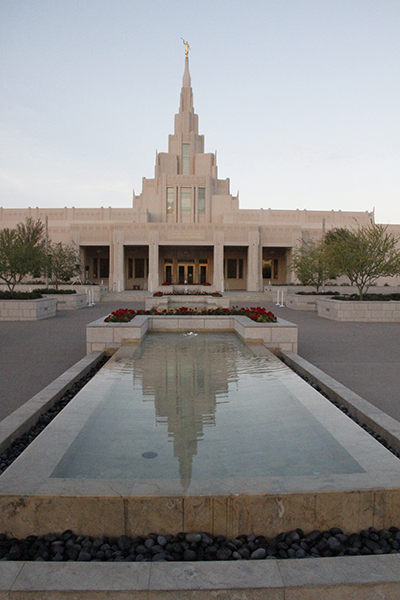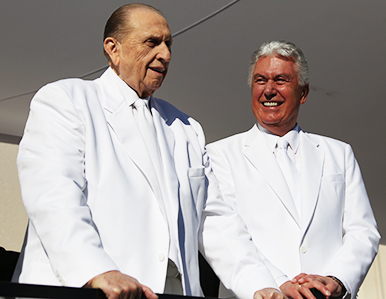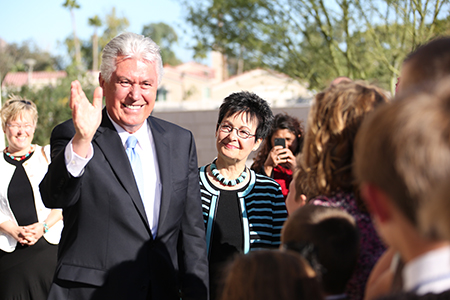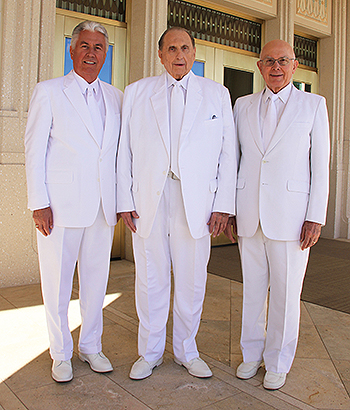Spiritual Waters of Phoenix Arizona Temple to Nourish Members
Contributed By Sarah Jane Weaver, Church News associate editor

Just as the ancient Hohokams relied on water to provide nourishment and life, Church members in the Phoenix Arizona temple district say they will rely on the living water that flows from the temple.
Related Links
PHOENIX, ARIZ.
In the year 1 A.D. the Hohokam Indians dug 135 miles of irrigation canals in the Arizona desert. The water, from the Salt and Gila Rivers, brought life and nourishment to a parched land.
The civilization thrived and by 1300 A.D., the Hohokams marked the largest population north of Mexico City.
But around 1450, the Hohokam culture disappeared from what is now Arizona—leaving their irrigation systems for those who would follow them.
In 1868, a prospector suggested the name of Phoenix for the area, because—like the mythological bird that would rise out of ashes—a new city was rising on the ruins of the former civilization (2014 Phoenix Arizona Temple Cultural Celebration, “Be a Light”).
President Thomas S. Monson dedicated a new temple in the city of Phoenix on November 16. Just as the ancient Hohokams relied on water to provide nourishment and life, Church members in the temple district say they will rely on the living water that flows from the temple.
“Water is central to the desert and the people that live here,” said Elder Kent F. Richards of the Seventy and executive director of the Church’s temple department. “It has always been carefully preserved to allow the desert to flourish.”

The Phoenix Arizona Temple, dedicated by President Thomas S. Monson on November 16, is the 144th operating temple of the Church worldwide and one of five in Arizona. Photo by Sarah Jane Weaver.

Crowds fill the grounds of the Phoenix Arizona Temple on Sunday, November 16, after it was dedicated by President Thomas S. Monson. Photo by Sarah Jane Weaver.

President Thomas S. Monson and President Dieter F. Uchtdorf, Second Counselor in the First Presidency, visit with the crowd at the Phoenix Arizona Temple dedication cornerstone ceremony on November 16.
 President Thomas S. Monson and President Dieter F. Uchtdorf, with his wife, Harriet, visit with the crowd at the Phoenix Arizona Temple dedication cornerstone ceremony on November 16. Photo by Sam Penrod, KSL.
President Thomas S. Monson and President Dieter F. Uchtdorf, with his wife, Harriet, visit with the crowd at the Phoenix Arizona Temple dedication cornerstone ceremony on November 16. Photo by Sam Penrod, KSL.

Sun rises behind cactus, located near the Phoenix Arizona Temple. Photo by Sarah Jane Weaver.
A spiritual water flows from the temple to the people, he continued. “In the gospel we think of the Savior as living water.”
The Phoenix Arizona Temple, the Church’s 144th worldwide and fifth in Arizona, sits on 5.19 acres and will serve 60,000 Latter-day Saints from 16 stakes. Surrounded by rolling hills and beautiful desert landscapes, the temple highlights a motif of aloe stalks and desert tree leaves and is decorated in earth tones enhanced with terracotta designs.
Three fountains are featured on the temple grounds. Together they form a symbolic river bringing water, and with it life and nourishment, to the parched Arizona desert.
President Monson noted that the temple was dedicated just weeks before Thanksgiving and encouraged members of the temple district to thank their Heavenly Father for the life-giving waters.
“May we be grateful for the opportunity to come here and partake of God’s goodness.”
Before dedicating the temple, President Monson greeted Church members and placed mortar in the temple’s cornerstone. President Monson also helped his great-grandchildren, Amelia Rose Dibb and Thomas David Dibb, put mortar in the cornerstone.
Also participating in the cornerstone ceremony were President Dieter F. Uchtdorf, second counselor in the First Presidency; Elder Dallin H. Oaks of the Quorum of the Twelve Apostles; other general authorities and the new temple presidency.
President Uchtdorf said it is a great blessing to witness a supernal event — “the opening of a door to a place that bridges heaven and earth. The Phoenix Arizona Temple stands as a witness to the restoration of the gospel of Jesus Christ and as a beacon to those searching for light and truth.”
Elder Richards said the new temple is a one-hour drive from the Mesa Arizona Temple, located on the other side of the valley. In addition to the Mesa and Phoenix temples, the Church has temples in Snowflake, Gila Valley and Gilbert, Arizona. A sixth temple, in Tucson, Arizona, has been announced. “That will adequately supply the need for temples in Arizona,” Elder Richards said.
The temples represent the growth of the LDS Church in the state, where there are now 96 stakes and more than 400,000 members, said Michael Dean Pickerd, local chairman of the temple dedication committee.
He said the temple site was selected because of the beauty of the location and because the largest percentage of the temple district population reside in the area around the temple.
He said many Church members have lived in the west valley their entire life and are thankful for the new temple. “It is a place for them to draw strength and spiritual inspiration and guidance,” he said. “There is a long legacy of pioneer families here. There is a long legacy of faithful members in Arizona.”
John R. Peterson, a pioneer member in Arizona, served as a bishop in Phoenix in the early 1960s; his ward encompassed much of the current Phoenix Arizona Temple district. As a child he climbed the hills that now surround the temple.
“The spring of living water from the temple is going to gush over this side of the valley,” he said.
Dan R. and Katie Morris also remember the temple site before growth impacted the area. “My brother farmed this land,” said Brother Morris, noting the area was once filled with citrus groves and rose gardens.
“The membership of the Church has grown,” he said, noting instead of citrus groves, houses now grow in the area.
Brother Morris said the canals, constructed thousands of years ago by the Hohokams, still supply water to the Phoenix valley. Even “a little water enabled this valley to flourish and allows it to thrive today. Our rain is very minimal. … We have captured all the water that used to run through the valley in various dams.
“The living water of the gospel is just like the water that flows through the rivers and nourishes a parched land.”
As a youth Paul D. Sorensen — who was born and raised in Phoenix — never dreamed there would be a temple in the west valley. “The ward I grew up in now encompasses 10 stakes,” he said.
A temple ”is something people had hoped and prayed for but it came sooner than most people thought,” he said.
Quoting Ezekiel 47, he said the Phoenix Arizona Temple will “heal and bring life.”
“The water is figurative for what really comes forth from the temple — the impact of the spirit,” he said. “The waters of this temple will give life to the members and to others. It will be a blessing beyond what we really understand ourselves.”

The Phoenix Arizona Temple, dedicated by President Thomas S.
Monson on November 16, is the 144th operating temple of the
Church worldwide and one of five in Arizona. Photo by Sarah Jane
Weaver.

A father and son take a turn placing mortar on the cornerstone.

Members pose for a photo at the dedication of the Phoenix Arizona Temple. Photo by Tyler Harris.

A choir performs at the cornerstone ceremony for the Phoenix
Arizona Temple. Photo by Sarah Jane Weaver.

President Dieter F. Uchtdorf and his wife, Sister Harriet Uchtdorf,
greet members waiting to attend the dedication of the Phoenix
Arizona Temple November 16. Photo by Sarah Jane Weaver.

President Dieter F. Uchtdorf and his wife, Sister Harriet Uchtdorf,
at the dedication of the Phoenix Arizona Temple November 16.
Photo by Sarah Jane Weaver.

President Thomas S. Monson, center, President Dieter F. Uchtdorf, left, and Elder Dallin H. Oaks stand outside the Phoenix Arizona Temple before the new temple was dedicated in three session on November 16. Photo by Sarah Jane Weaver.
